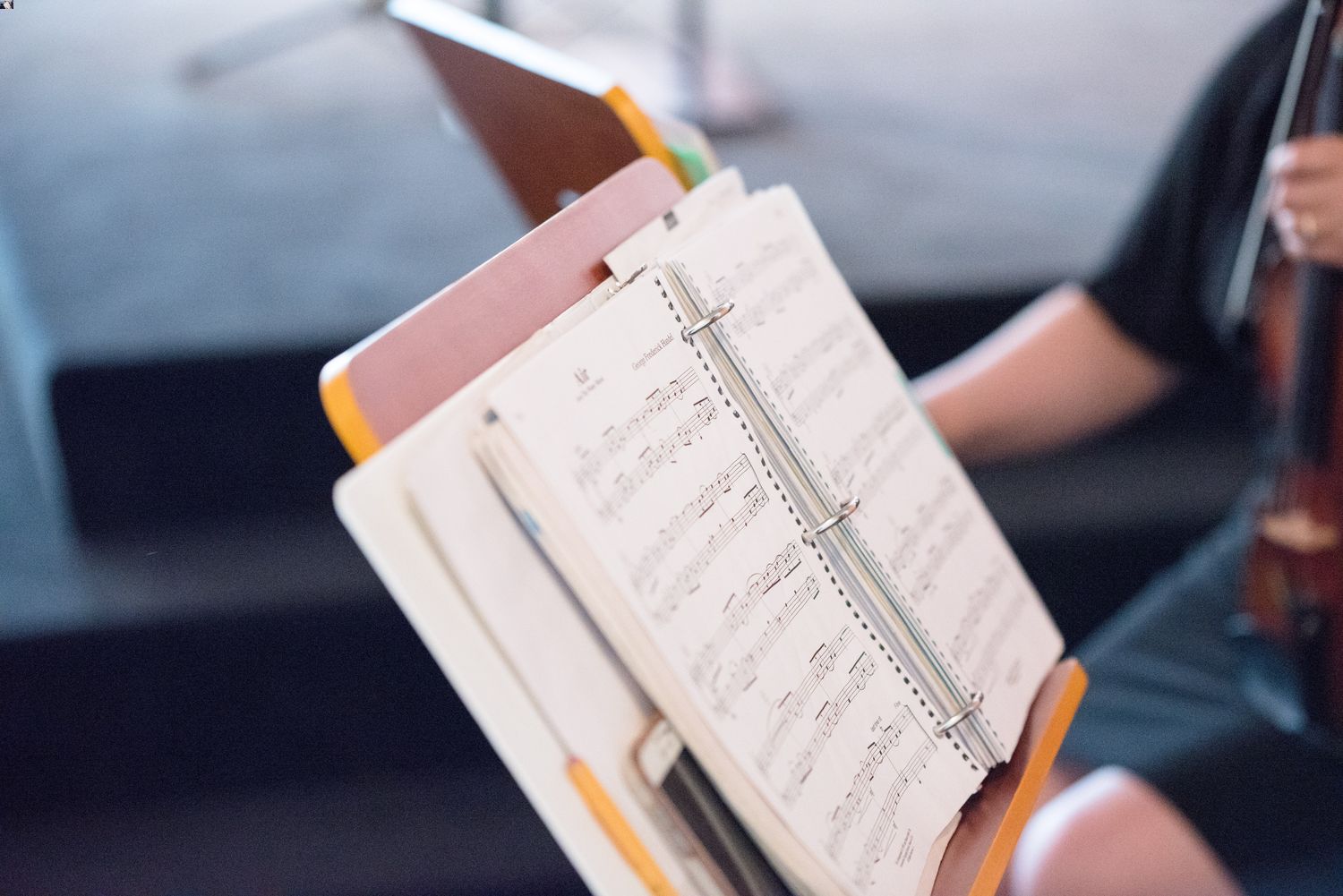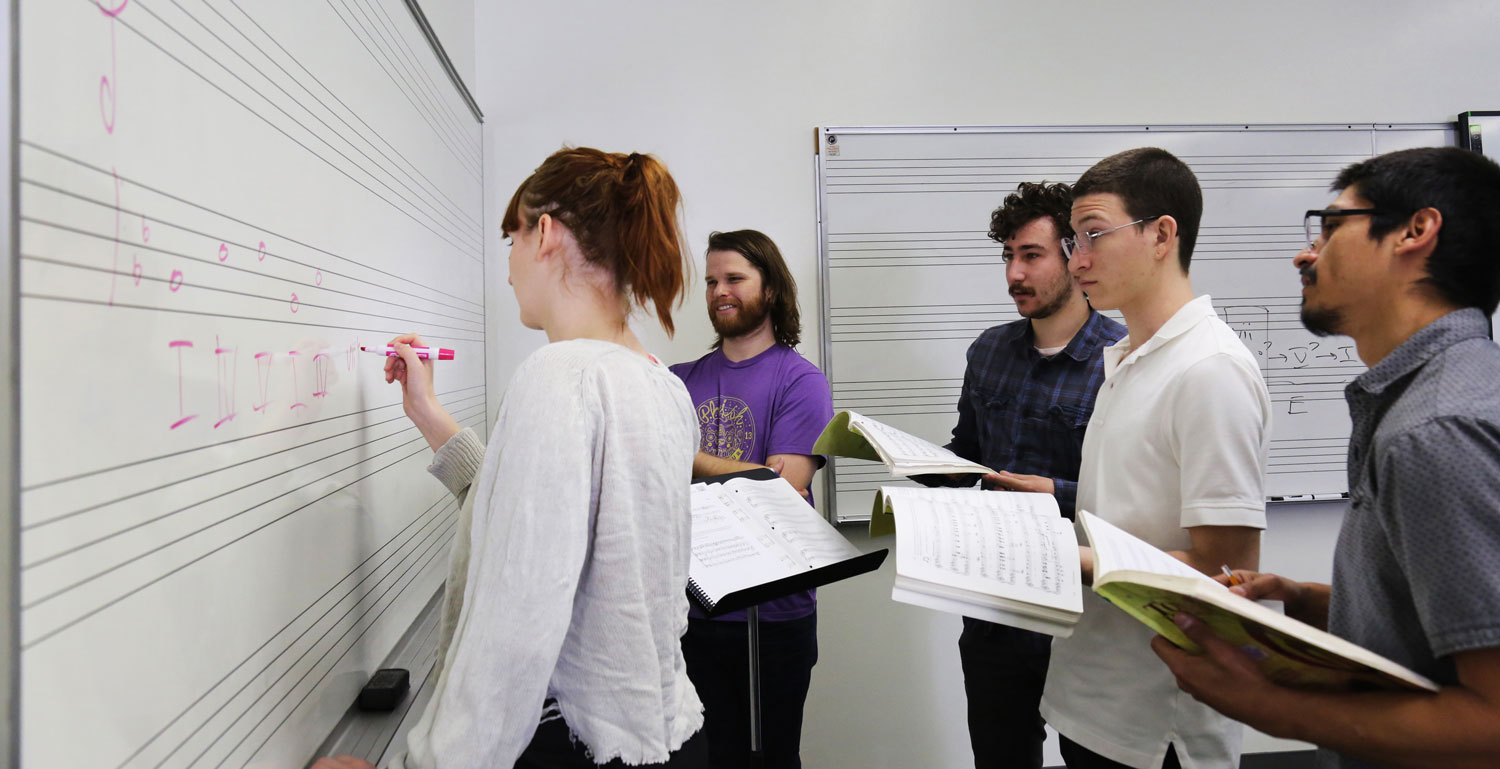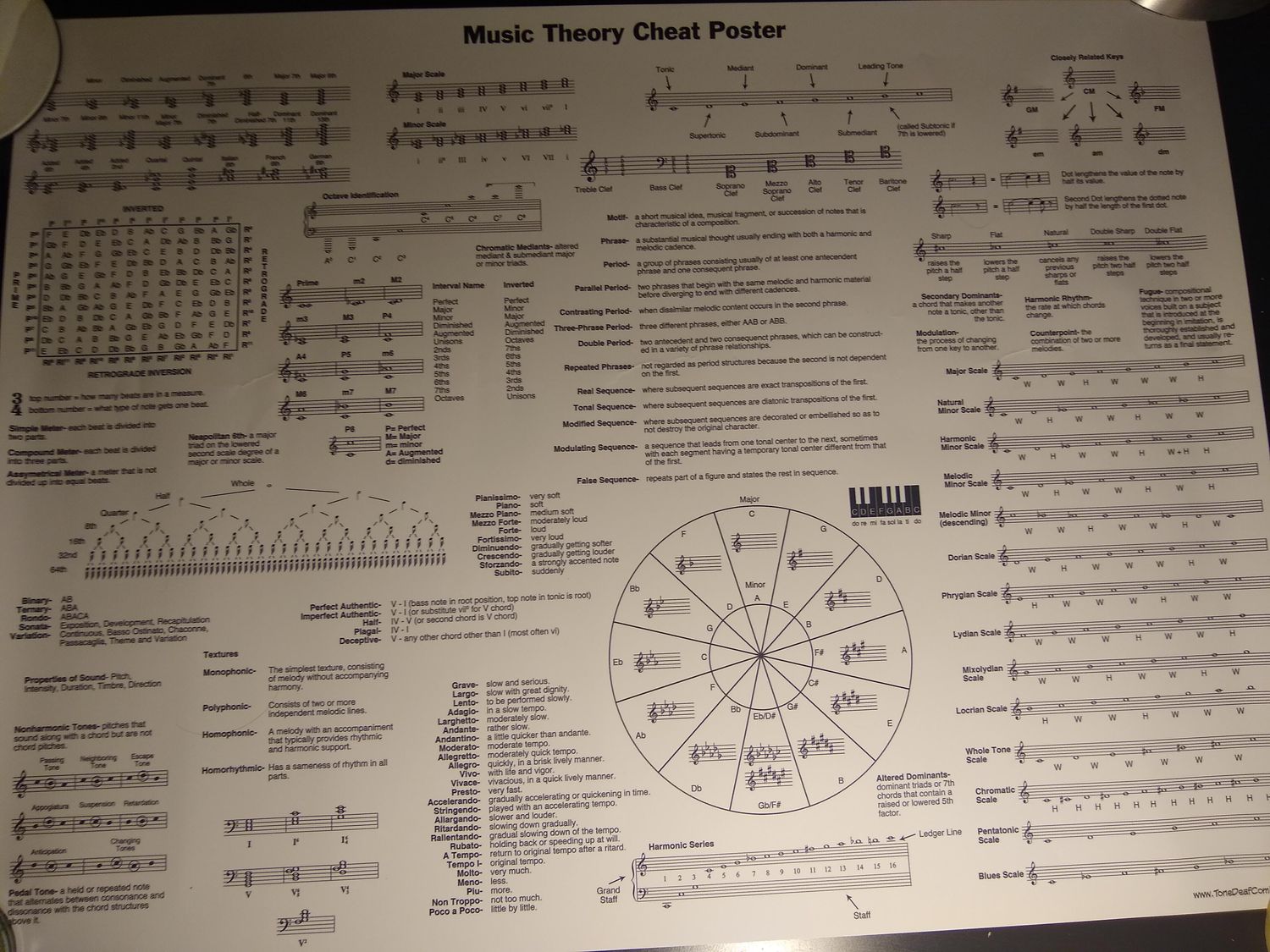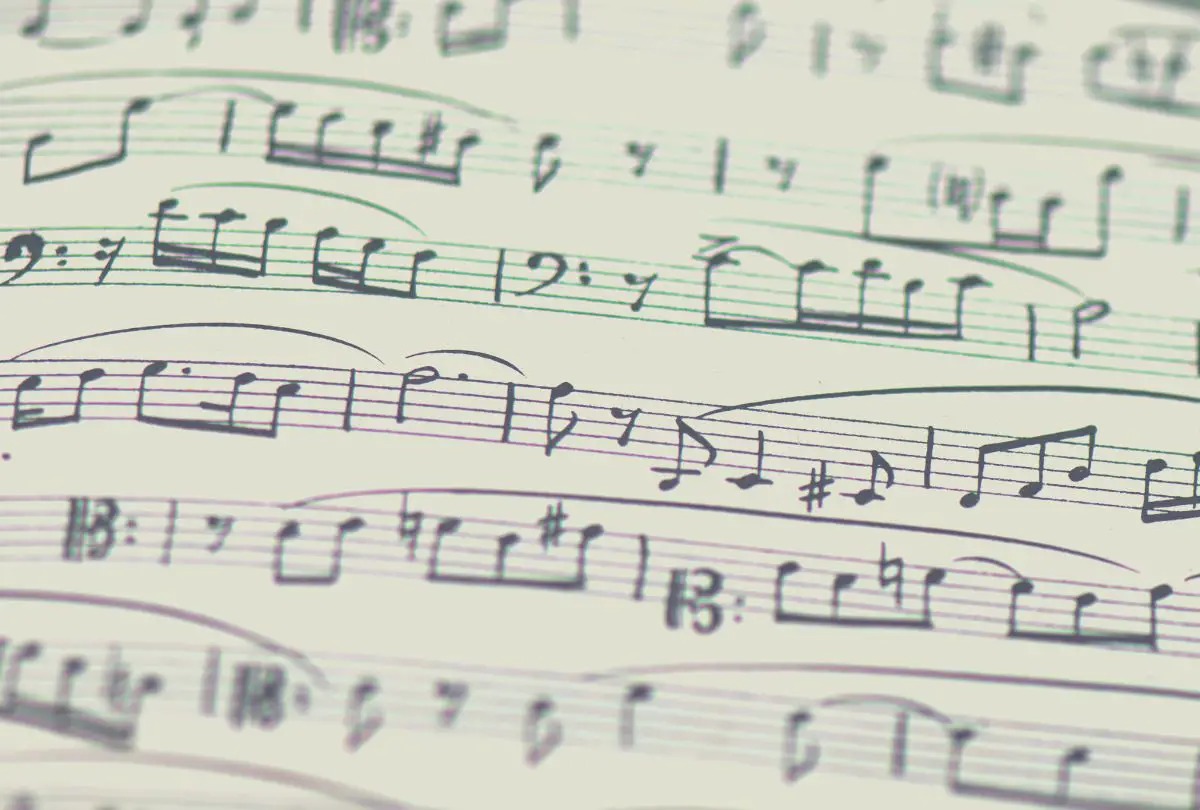Home>Production & Technology>Music Theory>What Will I Learn In Music Theory


Music Theory
What Will I Learn In Music Theory
Modified: February 9, 2024
Discover the essentials of music theory and learn how to read sheet music, understand chords and scales, and compose your own melodies. Dive into the world of music theory today!
(Many of the links in this article redirect to a specific reviewed product. Your purchase of these products through affiliate links helps to generate commission for AudioLover.com, at no extra cost. Learn more)
Table of Contents
Introduction
Music theory is the foundation of understanding and creating music. It is like learning the grammar, vocabulary, and syntax of a language; it allows musicians to communicate and express themselves effectively. Whether you are a beginner or an experienced musician, delving into the world of music theory can greatly enhance your musical knowledge and skills.
In this article, we will explore the different aspects of music theory and what you can expect to learn. From note names and notation to scales and modes, chords and harmony, rhythm and time signatures, and much more, we will cover a wide range of topics to give you a comprehensive understanding of music theory.
Music theory is not just for classical musicians or aspiring composers. It is relevant to musicians of all genres, including rock, jazz, pop, and electronic music. Understanding music theory can help you become a better songwriter, improviser, or performer, irrespective of the instrument you play.
While it may seem overwhelming at first, music theory is a rich and fascinating subject, and delving into its intricacies can be a rewarding journey. It will not only deepen your appreciation for music but also unlock new possibilities in your musical endeavors.
Whether you are just starting your musical journey or have been playing for years, studying music theory will provide you with a solid foundation to build upon. It is like learning the rules of a game before you can play it strategically and creatively.
So, let’s embark on this musical adventure together and explore the fascinating world of music theory. By the end of this article, you will have a clear understanding of what you can expect to learn and gain from studying music theory, and you will be ready to dive deeper into the world of music.
Basics of Music Theory
Before we dive into the specifics of music theory, it’s essential to understand some fundamental concepts that serve as the building blocks of music. These concepts include pitch, rhythm, and dynamics.
Pitch refers to the perceived frequency of a sound. In music, we use notes to represent different pitches. The pitch of a note is determined by its position on the musical staff, with higher positions representing higher pitches and lower positions representing lower pitches.
Rhythm is the arrangement of sounds and silences over time. It gives music its sense of movement and pulse. Musical notation, such as bar lines, time signatures, and note values, is used to represent the duration and timing of musical sounds.
Dynamics refer to the volume or intensity of a sound. It adds expression and emotional depth to music and can be indicated through symbols like pianissimo (very soft), piano (soft), mezzo piano (moderately soft), mezzo forte (moderately loud), forte (loud), and fortissimo (very loud).
Understanding these basic concepts is crucial when studying music theory as they provide a framework for comprehending the more complex elements that we will explore in the following sections.
Another crucial aspect of music theory is understanding the musical staff and notation. The musical staff consists of five lines and four spaces, onto which musical notes are placed. Each line and space represents a specific pitch.
The notes are written using the letters A through G, with variations indicated by accidentals such as sharps (#) and flats (b). These notes, combined with the use of ledger lines above and below the staff, allow for a wide range of pitches to be notated.
Music notation also includes other symbols such as rests, which indicate periods of silence, and various articulation marks, which show how a note should be played, such as staccato (short and detached) or legato (smooth and connected).
By familiarizing yourself with these basic concepts and symbols, you will be well-prepared to delve deeper into the fascinating world of music theory. In the next sections, we will explore note names and notation, scales and modes, chords and harmony, rhythm and time signatures, and more.
So, grab your instrument, or sit back and listen, as we embark on this musical journey together.
Note Names and Notation
In music theory, notes are represented by letters from A to G. These notes correspond to specific pitches on the musical staff. Understanding note names and notation is essential for reading and writing music.
The musical staff consists of five lines and four spaces. Each line and space represents a different pitch. The notes are written on the staff using a combination of noteheads, stems, and flags.
The letter names of the notes on the staff are A, B, C, D, E, F, and G. This sequence repeats as you move up or down the staff. Each note name represents a specific pitch, and its position on the staff determines its octave.
Notes on the staff can also be altered with accidentals. A sharp (#) raises a note by a half step, and a flat (b) lowers a note by a half step. These accidentals can be applied to any note, whether it is on a line or in a space.
Each notehead on the staff has a specific duration or note value. The most common note values include whole notes, half notes, quarter notes, eighth notes, and sixteenth notes. Whole notes are considered the longest in duration, while sixteenth notes are the shortest.
In addition to noteheads and note values, music notation also includes various symbols and markings to indicate articulation, dynamics, and expression. For example, a slur indicates that a group of notes should be played smoothly and connected, while a staccato mark indicates that the notes should be played short and detached.
Rests are also an important aspect of music notation. They represent periods of silence within a piece of music. Rests come in different durations, just like notes, and allow for pauses and rhythmic variation in a composition.
By understanding note names and notation, you will be able to read and write music with ease. Whether you are playing from sheet music, composing your own melodies, or transcribing songs, knowledge of note names and notation is essential.
Now that you have grasped the basics of note names and notation, we can move on to exploring scales and modes, which are the foundation of musical melodies and harmonies.
Scales and Modes
Scales and modes are fundamental concepts in music theory. They provide the framework for melodies and harmonies and serve as the basis for understanding and creating different musical styles and moods.
A scale is a sequence of pitches arranged in ascending or descending order. It is like a musical roadmap that determines the available notes for a piece of music. The most common scale in Western music is the major scale, which consists of seven different pitches.
The major scale follows a specific pattern of whole steps (W) and half steps (H) between the notes. The pattern is whole step, whole step, half step, whole step, whole step, whole step, half step (W-W-H-W-W-W-H).
For example, in the key of C major, the notes of the scale are C, D, E, F, G, A, and B. To play the C major scale on a piano, you would start with C, move to D, E, and so on, following the pattern of whole and half steps.
From the major scale, we can derive different modes. Modes are scales that share the same notes as the major scale but start from a different degree of the scale. The modes include Ionian (major), Dorian, Phrygian, Lydian, Mixolydian, Aeolian (natural minor), and Locrian.
Each mode has its unique sound and characteristic. For instance, the Dorian mode starts on the second degree of the major scale and has a minor feel, while the Lydian mode starts on the fourth degree and has a bright and uplifting quality.
Understanding scales and modes allows musicians to navigate and explore different tonalities and create melodies and harmonies that evoke specific emotions or convey a particular musical style.
By practicing scales and modes, musicians can improve their technique, ear training, and improvisation skills. They become familiar with the relationship between notes and develop a deeper understanding of musical structure and composition.
Whether you are a pianist, guitarist, vocalist, or any other type of musician, scales and modes are essential tools in your musical toolbox. They provide the foundation for musical expression and creativity.
Now that you have a grasp on scales and modes, we can move on to exploring chords and harmony, which are integral to constructing the chords progressions and harmonic structure of a piece of music.
Chords and Harmony
Chords and harmony play a vital role in music, adding depth and richness to melodies. Understanding chords and how they work harmonically is essential for musicians of all genres.
A chord is a collection of three or more notes played simultaneously. It is formed by stacking notes on top of each other, typically built on intervals of thirds. The root note of the chord is the starting point, from which the other notes are derived.
The most common type of chord is the triad, which consists of three notes. Triads are built using the root, a third (either major or minor), and a fifth. Major triads have a happy and bright sound, while minor triads have a more somber and melancholic feel.
For example, in the key of C major, the C major triad consists of the notes C, E, and G, while the C minor triad consists of the notes C, E♭, and G.
Chords can be represented using chord symbols, such as C, Cm, Cmaj7, C7, etc. These symbols allow musicians to quickly identify and play the chords within a piece of music.
Harmony refers to the combination of chords played together and how they interact. It is the vertical aspect of music, providing the foundation and support for melodies. Harmony encompasses chord progressions, cadences, and harmonic analysis.
Chord progressions are sequences of chords that create a sense of movement and resolution. They form the backbone of many songs and compositions. Common chord progressions include the I-IV-V (1-4-5) progression, which is widely used in popular music, and the ii-V-I (2-5-1) progression, commonly found in jazz.
Cadences are musical phrases or patterns that create a sense of closure or finality. They are often used at the end of musical phrases or sections. Common cadences include the authentic cadence (V-I), which provides a strong resolution, and the plagal cadence (IV-I), which has a more relaxed and less conclusive effect.
Harmonic analysis involves studying the chords and harmonic structure of a piece of music. It helps musicians identify patterns, progressions, and relationships between chords, enabling them to understand the underlying harmonic language and create their compositions or arrangements.
By understanding chords and harmony, musicians can create interesting arrangements, harmonize melodies, and improvise creatively. Whether you are a songwriter, an accompanist, or a solo performer, a solid understanding of chords and harmony is essential for musical expression.
Now that you have a grasp of chords and harmony, we can explore the rhythmic aspects of music theory, including rhythm and time signatures.
Rhythm and Time Signatures
Rhythm is the heartbeat of music, providing a sense of groove, movement, and structure. Understanding rhythm and time signatures is crucial for musicians to play together in sync and create rhythmic patterns that complement the melody and harmony.
Rhythm is the arrangement of sounds and silences in music. It is characterized by the duration and placement of notes and rests. By combining different note values and articulations, musicians can create a wide variety of rhythmic patterns.
Time signatures are numerical symbols placed at the beginning of a musical piece or section to indicate the meter or pulse of the music. The top number represents the number of beats per measure, while the bottom number indicates the note value that receives one beat.
For example, in a 4/4 time signature (also known as common time), there are four beats per measure, and the quarter note receives one beat. This time signature is widely used in various music genres and provides a steady and balanced rhythmic feel.
Other common time signatures include 3/4 (waltz time), where there are three beats per measure and the quarter note receives one beat, and 6/8 (compound time), where there are six beats per measure and the eighth note receives one beat.
Rhythm and time signatures go hand in hand, determining the overall feel and rhythmic structure of a piece of music. By adopting different time signatures, musicians can create variations in tempo, groove, and syncopation.
Syncopation is an important concept in rhythm where accents are placed on weak beats or offbeats. It adds rhythmic interest and creates a sense of tension and release. Syncopated rhythms can be found in various music styles, including jazz, Latin, and funk.
Understanding rhythm and time signatures allows musicians to read and interpret sheet music accurately. It also enables them to communicate and collaborate effectively with other musicians during rehearsals and performances.
Developing a strong sense of rhythm involves practicing with a metronome, studying different rhythmic patterns, and listening to various musical genres. It is a skill that can be honed and refined over time through consistent practice and exposure to diverse rhythmic styles.
Now that you have a grasp of rhythm and time signatures, we can explore another essential aspect of music theory: intervals and transposition.
Intervals and Transposition
Intervals and transposition are important concepts in music theory that help musicians understand and navigate the relationship between different pitches and keys. They provide a framework for melody writing, harmonization, and improvisation.
An interval is the distance between two pitches. It can be measured in terms of semitones or whole steps. Understanding intervals allows musicians to identify and describe the relationship between notes, whether they are played simultaneously (harmonically) or in succession (melodically).
There are several types of intervals, including major, minor, perfect, augmented, and diminished. The intervals are named based on their size in terms of semitones and their role within a particular scale or key.
For example, the interval between two adjacent keys on a piano, such as C and C#, is a minor second (1 semitone). The interval between C and D is a major second (2 semitones). The interval between C and E is a major third (4 semitones), and so on.
Transposition involves shifting a piece of music or a musical phrase to a different key. This can be done by raising or lowering all the pitches by the same interval. Transposition allows musicians to change the key of a song to suit their vocal range or to create a different musical interpretation.
Transposing music is particularly useful for accommodating different instruments or vocal ranges. It allows musicians to play a piece in a key that is comfortable for them while maintaining the original melodic and harmonic content.
Transposition also plays a crucial role in music composition, as it allows composers to explore different tonalities and create variations of their musical ideas. It adds versatility and flexibility to the musical landscape.
By understanding intervals and transposition, musicians can explore different harmonic possibilities, create unique melodies, and improvise freely within a given musical context. It enables them to transpose melodies, chords, or entire songs on the fly, opening up new creative pathways.
Developing a strong ear for intervals is essential for accurate transposition and overall musicianship. By practicing interval recognition exercises and actively listening to the interactions between different pitches, musicians can improve their ability to identify intervals and apply transposition techniques effectively.
Now that you have a grasp of intervals and transposition, we can move on to exploring key signatures and the circle of fifths, which are crucial tools for understanding tonal relationships and the organization of musical keys.
Key Signatures and Circle of Fifths
Key signatures and the circle of fifths are essential tools in music theory that help musicians understand the relationship between different keys and the organization of musical tonality.
A key signature is a set of sharps or flats placed at the beginning of a musical staff, immediately after the clef symbol. It indicates the key in which a piece of music is written and tells the musician which notes to sharpen or flatten throughout the piece.
The key signature is a reflection of the tonality of the piece. Major keys are characterized by their specific pattern of whole and half steps, and each major key has a corresponding key signature. For example, the key of C major has no sharps or flats, while the key of G major has one sharp (F#).
Minor keys have their own unique key signatures as well. The natural minor scale follows a different pattern of whole and half steps, and its key signature indicates the notes that are altered from their natural state. For example, the key of A minor has no sharps or flats, while the key of E minor has one sharp (F#).
The circle of fifths is a graphical representation of the relationships between different keys. It is constructed by moving in fifths (or in fourths, which is the reverse direction), starting from the key of C and moving clockwise around the circle.
Each key on the circle is a perfect fifth apart from its neighboring keys. For example, moving from the key of C to the key of G, you go up a perfect fifth. The circle of fifths provides a visual and harmonic sequence that shows the progressive addition of sharps or flats in the key signatures.
The circle of fifths is a valuable tool for understanding harmonic relationships, chord progressions, and modulation between keys. It helps musicians analyze and predict chord changes and provides a framework for improvisation and composition.
By studying key signatures and the circle of fifths, musicians can develop a deeper understanding of tonal relationships and enhance their musical comprehension. It allows them to navigate through different keys more confidently, transpose music accurately, and appreciate the harmonic complexity of musical compositions.
Now that you have a grasp on key signatures and the circle of fifths, we can explore other important aspects of music theory, such as musical forms and analysis.
Musical Forms and Analysis
Musical forms and analysis provide a framework for understanding the structure and organization of musical compositions. By examining the underlying patterns and techniques used by composers, musicians can gain valuable insights into the intentions and intricacies of a piece of music.
Musical form refers to the way a piece of music is structured, determining how its various sections are organized and related to each other. Different musical forms have emerged throughout history, ranging from simple binary forms, such as A-B or A-A-B, to more complex forms like sonata form, rondo form, and theme and variations.
Binary form consists of two contrasting sections, often labeled as A and B. It is commonly found in dances and folk music. Ternary form, on the other hand, consists of three sections – A-B-A. It allows for a return to the first section after a contrasting middle section.
Sonata form, used extensively in classical music, is a more elaborate form that typically consists of three main sections – exposition, development, and recapitulation. This form allows for the exploration and development of musical ideas and themes.
Rondo form is characterized by a recurring main theme that alternates with contrasting sections. It typically follows the pattern A-B-A-C-A and can be found in many classical compositions.
Theme and variations involves taking a basic musical theme and presenting it in various altered forms, exploring different melodic, harmonic, or rhythmic variations while maintaining the underlying theme.
Musical analysis involves studying and dissecting a piece of music to uncover its structural and compositional elements. It involves identifying key signatures, chord progressions, melodic motifs, and harmonic relationships.
Analysis allows musicians to understand the composer’s intentions better, interpret the music more thoughtfully, and make informed decisions about phrasing, dynamics, and expressive nuances. Analyzing music also provides a deeper appreciation for the compositional techniques utilized.
By studying musical forms and analysis, musicians can develop a trained ear and a critical mindset when listening to and performing music. It enhances their understanding of the compositional choices made by the composer and helps them interpret and communicate the music effectively.
Now that you have a grasp of musical forms and analysis, we can explore other aspects of music theory, such as melody writing and counterpoint.
Melody Writing and Counterpoint
Melody is the heart and soul of music, and the art of melody writing is a fundamental skill for composers and songwriters. A well-crafted melody can captivate the listener, evoke emotions, and leave a lasting impression.
When writing a melody, it is essential to consider factors such as contour, rhythm, phrasing, and harmony. The contour refers to the shape or trajectory of the melody, whether it rises, falls, or stays relatively stable. Rhythm determines the timing and duration of notes, creating a sense of pacing and pulse.
Phrasing involves dividing the melody into smaller musical phrases, allowing for natural breaths and pauses. It helps give the melody a sense of structure and coherence. Harmony plays a crucial role in melody writing by providing the underlying chords and providing context for the melodic notes.
Counterpoint is the art of combining multiple melodic lines in a harmonically pleasing and independent manner. It focuses on the interaction between melodies, ensuring that each line is distinctive and interesting, yet harmonically coherent when played together.
Counterpoint techniques include creating parallel motion, where two or more melodic lines move in the same direction with the same intervals between them. Contrary motion involves melodies moving in opposite directions. Oblique motion occurs when one melodic line stays the same while the other moves up or down.
The rules of counterpoint often involve maintaining independent melodic lines, avoiding parallel fifths and octaves, and resolving dissonances according to specific guidelines. However, it’s important to note that counterpoint rules have evolved over time, and composers often bend or break these rules for artistic expression.
Studying and practicing counterpoint can sharpen a composer’s ear, enhance their understanding of harmony, and expand their creative possibilities in composing multi-layered music. It encourages compositional fluency and provides a solid foundation for more advanced forms of composition.
By mastering the art of melody writing and counterpoint, musicians can craft compelling and memorable melodies, experiment with harmonic interplay, and create intricate musical textures. These skills lay the groundwork for composing original music that resonates with listeners.
Now that you have a grasp of melody writing and counterpoint, we can explore other important topics in music theory, such as ear training and sight-singing.
Ear Training and Sight-Singing
Ear training and sight-singing are essential skills for musicians that enhance their ability to recognize and reproduce musical sounds accurately. These skills improve musicians’ overall musicality and enable them to communicate and collaborate effectively with other performers.
Ear training involves developing the ability to identify and differentiate musical elements such as pitches, intervals, chords, and rhythms solely by ear. It helps musicians develop a keen sense of relative pitch, allowing them to recognize and reproduce melodies, harmonies, and rhythms without relying solely on sheet music.
Through ear training exercises, musicians learn to identify intervals by their distinctive sound, recognize chord qualities, transcribe melodies from recordings, and develop strong rhythmic accuracy. These skills are particularly valuable for improvising, harmonizing melodies, and playing by ear.
Sight-singing, on the other hand, is the ability to read and sing music from sheet music or musical notation. It involves simultaneously interpreting the pitch, rhythm, dynamics, and phrasing of the written music and translating it into vocal or instrumental performance.
Through sight-singing exercises, musicians learn to quickly analyze musical notation, understand key signatures and time signatures, and develop the ability to sing or play music accurately upon first sight. This skill is particularly important for choral singers, instrumentalists in an ensemble setting, and those studying classical music.
Ear training and sight-singing are often taught and practiced together as they complement each other. Ear training improves sight-singing by enabling musicians to audiate or mentally hear the music as they read the notation. Sight-singing, in turn, reinforces a musician’s ability to accurately produce pitches, rhythms, and musical phrasing.
Regular practice of ear training and sight-singing exercises can greatly enhance a musician’s overall musicianship. It fine-tunes their pitch perception, improves their ability to internalize and reproduce musical patterns, and enhances their capacity to perform with accuracy and expressiveness.
Developing these skills also fosters a deeper connection to music, as musicians can appreciate and understand the nuances and subtleties within a musical composition. It enables musicians to bring life and personal interpretation to the written music, creating a more meaningful and engaging performance.
Now that you have a grasp of ear training and sight-singing, we can explore other aspects of music theory or conclude our journey through the key elements of musical understanding.
Conclusion
Congratulations! You have journeyed through the key elements of music theory, gaining valuable insights into the language, structure, and expression of music. By understanding the basics of music theory, including note names and notation, scales and modes, chords and harmony, rhythm and time signatures, intervals and transposition, key signatures and the circle of fifths, musical forms and analysis, melody writing and counterpoint, and ear training and sight-singing, you have equipped yourself with a solid foundation for musical exploration and creativity.
Music theory provides a roadmap for musicians to understand and communicate musical ideas effectively. It enhances our ability to appreciate, interpret, and express ourselves through music. Whether you are a beginner learning to play an instrument or an experienced musician looking to deepen your understanding, music theory is an invaluable tool for your musical journey.
Remember, while music theory provides guidelines and concepts, it also encourages freedom and creativity. Use your newfound knowledge to expand your musical horizons, experiment with different styles and techniques, and develop your unique musical voice.
Continue to practice and refine your skills, as mastery in music theory comes with time, dedication, and a lifelong love for music. Embrace the joy of discovering new melodies, exploring harmonies, and crafting expressive performances.
As you continue your musical journey, let the knowledge of music theory be your guide, supporting your growth as a musician, performer, composer, or music enthusiast. Keep listening, learning, and creating, and let the beauty and power of music guide your artistic expression.
Enjoy the exciting and ever-expanding world of music theory and let it open doors to new possibilities in your musical endeavors. Let your creativity soar and share your love for music with the world.
Happy exploring and creating music!











